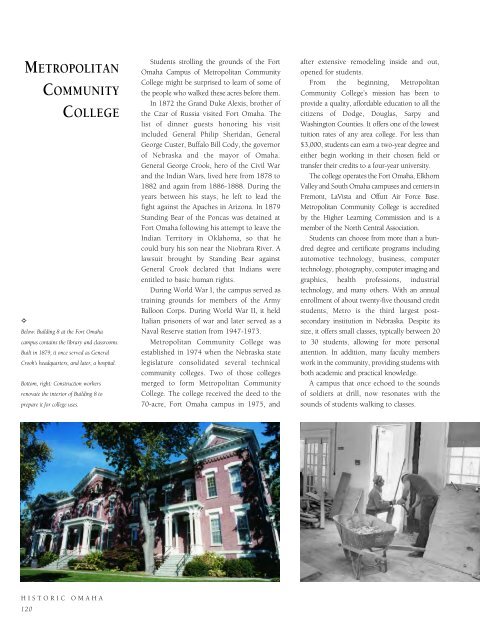Historic Omaha
An illustrated history of Omaha and the Douglas County area, paired with the histories of companies, families and organizations that make the region great.
An illustrated history of Omaha and the Douglas County area, paired with the histories of companies, families and organizations that make the region great.
You also want an ePaper? Increase the reach of your titles
YUMPU automatically turns print PDFs into web optimized ePapers that Google loves.
METROPOLITAN<br />
COMMUNITY<br />
COLLEGE<br />
✧<br />
Below: Building 8 at the Fort <strong>Omaha</strong><br />
campus contains the library and classrooms.<br />
Built in 1879, it once served as General<br />
Crook’s headquarters, and later, a hospital.<br />
Bottom, right: Construction workers<br />
renovate the interior of Building 8 to<br />
prepare it for college uses.<br />
Students strolling the grounds of the Fort<br />
<strong>Omaha</strong> Campus of Metropolitan Community<br />
College might be surprised to learn of some of<br />
the people who walked these acres before them.<br />
In 1872 the Grand Duke Alexis, brother of<br />
the Czar of Russia visited Fort <strong>Omaha</strong>. The<br />
list of dinner guests honoring his visit<br />
included General Philip Sheridan, General<br />
George Custer, Buffalo Bill Cody, the governor<br />
of Nebraska and the mayor of <strong>Omaha</strong>.<br />
General George Crook, hero of the Civil War<br />
and the Indian Wars, lived here from 1878 to<br />
1882 and again from 1886-1888. During the<br />
years between his stays, he left to lead the<br />
fight against the Apaches in Arizona. In 1879<br />
Standing Bear of the Poncas was detained at<br />
Fort <strong>Omaha</strong> following his attempt to leave the<br />
Indian Territory in Oklahoma, so that he<br />
could bury his son near the Niobrara River. A<br />
lawsuit brought by Standing Bear against<br />
General Crook declared that Indians were<br />
entitled to basic human rights.<br />
During World War I, the campus served as<br />
training grounds for members of the Army<br />
Balloon Corps. During World War II, it held<br />
Italian prisoners of war and later served as a<br />
Naval Reserve station from 1947-1973.<br />
Metropolitan Community College was<br />
established in 1974 when the Nebraska state<br />
legislature consolidated several technical<br />
community colleges. Two of those colleges<br />
merged to form Metropolitan Community<br />
College. The college received the deed to the<br />
70-acre, Fort <strong>Omaha</strong> campus in 1975, and<br />
after extensive remodeling inside and out,<br />
opened for students.<br />
From the beginning, Metropolitan<br />
Community College’s mission has been to<br />
provide a quality, affordable education to all the<br />
citizens of Dodge, Douglas, Sarpy and<br />
Washington Counties. It offers one of the lowest<br />
tuition rates of any area college. For less than<br />
$3,000, students can earn a two-year degree and<br />
either begin working in their chosen field or<br />
transfer their credits to a four-year university.<br />
The college operates the Fort <strong>Omaha</strong>, Elkhorn<br />
Valley and South <strong>Omaha</strong> campuses and centers in<br />
Fremont, LaVista and Offutt Air Force Base.<br />
Metropolitan Community College is accredited<br />
by the Higher Learning Commission and is a<br />
member of the North Central Association.<br />
Students can choose from more than a hundred<br />
degree and certificate programs including<br />
automotive technology, business, computer<br />
technology, photography, computer imaging and<br />
graphics, health professions, industrial<br />
technology, and many others. With an annual<br />
enrollment of about twenty-five thousand credit<br />
students, Metro is the third largest postsecondary<br />
institution in Nebraska. Despite its<br />
size, it offers small classes, typically between 20<br />
to 30 students, allowing for more personal<br />
attention. In addition, many faculty members<br />
work in the community, providing students with<br />
both academic and practical knowledge.<br />
A campus that once echoed to the sounds<br />
of soldiers at drill, now resonates with the<br />
sounds of students walking to classes.<br />
HISTORIC OMAHA<br />
120
















